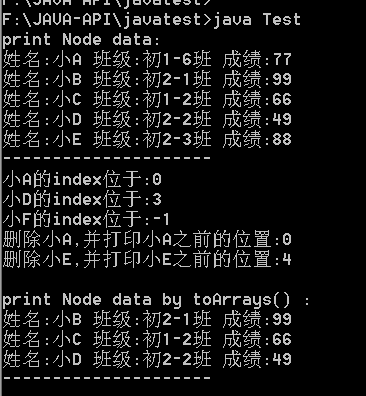1.实现链表的步骤
- 1).实现Node节点类(用来保存链表中每个节点的数据,以及下一个节点成员)
- 2).实现LinkList链表类(用来封装Node节点类,和用户实现交互)
- 3).在LinkList类里,实现添加,删除,根据要查的Node数据来找表中的序号,根据要查的序号来找对应的Node数据.
- 4).在LinkList类里,实现toArrays方法,用来取出链表中的Node数据的数组
2.类的实现
/*节点类*/ class Node { private String data; //节点保存的数据 private Node next; //下个节点 public Node(String data){ this.data = data; } public String getData() { return data; } public void setData(String data) { this.data = data; } public Node getNext() { return next; } public void setNext(String data) { this.next = new Node(data); } /*Description: 添加节点 *return : */ public void addNode(String data) { if(getNext()!=null) { this.next.addNode(data); } else { this.setNext(data); } } /*Description: 获取节点数据 *return : */ public String getData(int index) { String ret =null ; if(index == 0) //如果递归到0,则返回当前数据 { ret=data; } else //否则继续递归查找 { ret=this.next.getData(--index); } return ret; } /*Description: 递归地查找data位于链表哪个序号 *return : -1(表示未找到) */ public int findIndex(String data,int index) { if(this.data.equals(data)) //已找到 { return index; } else if (getNext()==null) //未找到 { return -1; } return this.next.findIndex(data,++index); } /*Description: 递归地查找data,并删除 *data: 要找的data *PreNode: 上个节点,如果为null则当前位于表头 *index: 表示当前位于链表哪个序号 *return : -1(表示未找到) 0~(len-1) (表示data位于链表哪个序号) */ public int delData(String data,Node PreNode,int index) { int ret = -1; if(this.data.equals(data)) //删除 { PreNode.next = this.next; return index; } else if (getNext()==null) //未找到 { return ret; } return this.next.delData(data,this,++index); } } /*链表类*/ class LinkList { private Node next; //负责管理的节点 private int len; //统计节点长度 public LinkList(String data) { next = new Node(data); len =1; } /*Description: 添加一个节点数据 *return : */ public void addData(String data) { this.next.addNode(data); len++; } /*Description: 删除一个节点数据 *return : -1(未找到要删除的数据) 0~(len-1) (表示data位于链表哪个序号) */ public int delData(String data) { int ret=-1; if(len>=0) //链表有数据 { if(this.next.getData().equals(data)) //删除表头需要特殊处理 { this.next = this.next.getNext(); ret = 0; } else ret = next.delData(data,this.next,1); } if(ret!= -1) //已删除 { len--; } return ret; } /*Description: 根据index找到对应的节点数据 *return : 返回节点数据 */ public String getNodeData(int index) { String ret=null; if(index>=0 && index<(len)) { ret = next.getData(index); } return ret; } /*Description: 根据data查找节点Node位于链表哪个序号 *return : -1(表示未找到) 0~(len-1) (表示data位于链表哪个序号) */ public int findNodeIndex(String data) { int ret=-1; if(len>=0) //链表有数据 { ret = next.findIndex(data,0); //从序号0开始找 } return ret; } /*Description: 将链表中所有的节点数据转为数组 *return : */ public String[] toArrays() { Node tmp=this.next; String[] arr = new String[len]; for(int i=0; i< len; i++) { arr[i] = tmp.getData(); tmp = tmp.getNext(); } return arr; } public int length() { return len; } }
3.测试代码
public class Test{ public static void main(String args[]){ LinkList list = new LinkList("小A"); //添加节点数据 list.addData("小B"); list.addData("小C"); list.addData("小D"); list.addData("小E"); //打印节点数据 System.out.println("print Node data:"); for(int i=0;i<list.length();i++) { System.out.println(list.getNodeData(i)); } System.out.println("---------------------"); //查找节点数据的序号 System.out.println("小A的index位于:"+list.findNodeIndex("小A")); System.out.println("小D的index位于:"+list.findNodeIndex("小D")); System.out.println("小F的index位于:"+list.findNodeIndex("小F")); //返回-1,表示未找到 //删除节点数据 System.out.println("删除小A,并打印小A之前的位置:"+list.delData("小A")); System.out.println("删除小E,并打印小E之前的位置:"+list.delData("小E")); //通过数组打印数据 System.out.println(" print Node data by toArrays() :"); String[] arr=list.toArrays(); for(int i=0;i<arr.length;i++) { System.out.println(arr[i]); } System.out.println("---------------------"); } }
运行打印:

PS:这样写,只是简单的实现某个数据类型的链表.在后面我们学习了JAVA-Object类,由于Object类是所有类的超类,所以,我们可以来实现满足所有类型的链表
接下来开始重新修改链表.
4.修改链表-将节点数据改为Object类型
class Node { private Object data; //节点保存的数据 private Node next; //下个节点 public Node(Object data){ this.data = data; } public Object getData() //获取数据 { return data; } public void setData(Object data) { this.data = data; } public Node getNext() { return next; } public void setNext(Object data) { this.next = new Node(data); } /*Description: 添加节点 *return : */ public void addNode(Object data) { if(getNext()!=null) { this.next.addNode(data); } else { this.setNext(data); } } /*Description: 获取节点数据 *return : */ public Object getData(int index) { Object ret =null ; if(index == 0) //如果递归到0,则返回当前数据 { ret=data; } else //否则继续递归查找 { ret=this.next.getData(--index); } return ret; } /*Description: 递归地查找data位于链表哪个序号 *return : -1(表示未找到) */ public int findIndex(Object data,int index) { if(this.data.equals(data)) //已找到 { return index; } else if (getNext()==null) //未找到 { return -1; } return this.next.findIndex(data,++index); } /*Description: 递归地查找data,并删除 *data: 要找的data *PreNode: 上个节点,如果为null则当前位于表头 *index: 表示当前位于链表哪个序号 *return : -1(表示未找到) 0~(len-1) (表示data位于链表哪个序号) */ public int delData(Object data,Node PreNode,int index) { int ret = -1; if(this.data.equals(data)) //删除 { PreNode.next = this.next; return index; } else if (getNext()==null) //未找到 { return ret; } return this.next.delData(data,this,++index); } } /*链表类*/ class LinkList { private Node next; //负责管理的节点 private int len; //统计节点长度 public LinkList(Object data) { next = new Node(data); len =1; } /*Description: 添加一个节点数据 *return : */ public void addData(Object data) { this.next.addNode(data); len++; } /*Description: 删除一个节点数据 *return : -1(未找到要删除的数据) 0~(len-1) (表示data位于链表哪个序号) */ public int delData(Object data) { int ret=-1; if(len>=0) //链表有数据 { if(this.next.getData().equals(data)) //删除表头需要特殊处理 { this.next = this.next.getNext(); ret = 0; } else ret = next.delData(data,this.next,1); } if(ret!= -1) //已删除 { len--; } return ret; } /*Description: 根据index找到对应的节点数据 *return : 返回节点数据 */ public Object getNodeData(int index) { Object ret=null; if(index>=0 && index<(len)) { ret = next.getData(index); } return ret; } /*Description: 根据data查找节点Node位于链表哪个序号 *return : -1(表示未找到) 0~(len-1) (表示data位于链表哪个序号) */ public int findNodeIndex(Object data) { int ret=-1; if(len>=0) //链表有数据 { ret = next.findIndex(data,0); //从序号0开始找 } return ret; } /*Description: 将链表中所有的节点数据转为数组 *return : */ public String[] toArrays() { Node tmp=this.next; String[] arr = new String[len]; for(int i=0; i< len; i++) { arr[i] = tmp.getData().toString(); tmp = tmp.getNext(); } return arr; } public int length() { return len; } }
5.测试修改后的链表
接下来,我们便来写一个student学生类,然后通过我们修改后的链表来保存该类
5.1 student学生类如下所示:
/*学生类*/ class Student { String name; //名字 String clas; //班级 int score; //成绩 Student(String name,String clas,int score) { this.name = name; this.clas = clas; this.score = score; } /*覆写Object类的equals方法*/ public boolean equals(Object obj) { if(obj == null) //地址为null return false; if(obj instanceof Student == false) //非本类 { System.out.println("ERR"); return false; } if(this == obj) //地址相同 return true; Student st = (Student)obj; if(this.name.equals(st.name) && this.clas.equals(st.clas) && this.score == st.score ) return true; return false; } /*覆写Object类的toString方法*/ public String toString() { return "姓名:"+name+" 班级:"+clas+" 成绩:"+score; } }
5.2 student学生类的测试代码如下所示:
Student xiaoA = new Student("小A","初1-6班",77); Student xiaoB = new Student("小B","初2-1班",99); Student xiaoC = new Student("小C","初1-2班",66); Student xiaoD = new Student("小D","初2-2班",49); Student xiaoE = new Student("小E","初2-3班",88); Student xiaoF = new Student("小F","初2-3班",89); //创建链表,并添加 xiaoA 链表节点 LinkList list = new LinkList(xiaoA); //继续添加节点数据 list.addData(xiaoB); list.addData(xiaoC); list.addData(xiaoD); list.addData(xiaoE); //打印节点数据 System.out.println("print Node data:"); for(int i=0;i<list.length();i++) { System.out.println(list.getNodeData(i)); } System.out.println("---------------------"); //查找节点数据的序号 System.out.println("小A的index位于:"+list.findNodeIndex(xiaoA)); System.out.println("小D的index位于:"+list.findNodeIndex(xiaoD)); System.out.println("小F的index位于:"+list.findNodeIndex(xiaoF)); //返回-1,表示未找到 //删除节点数据 System.out.println("删除小A,并打印小A之前的位置:"+list.delData(xiaoA)); System.out.println("删除小E,并打印小E之前的位置:"+list.delData(xiaoE)); //通过数组打印数据 System.out.println(" print Node data by toArrays() :"); String[] arr=list.toArrays(); for(int i=0;i<arr.length;i++) { System.out.println(arr[i]); } System.out.println("---------------------");
5.3 打印如下:
